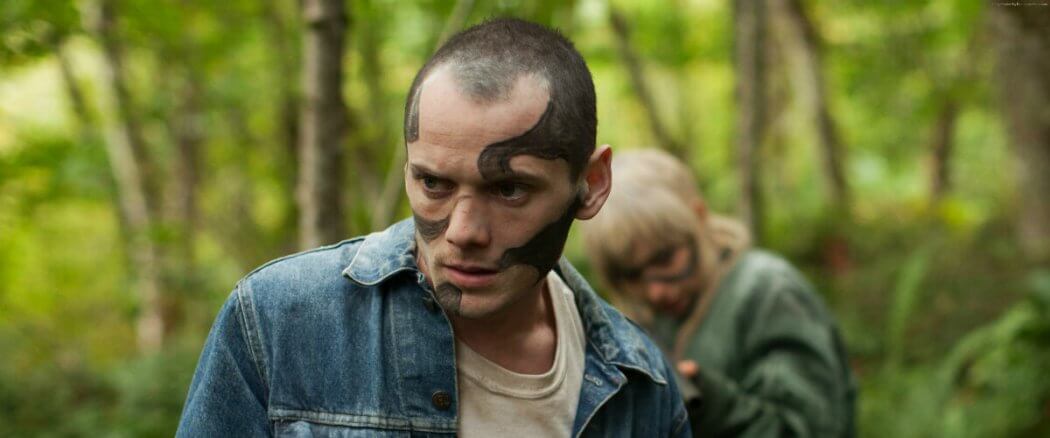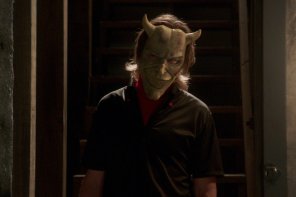Green Room arrives in theaters on a tidal wave of hype. It killed on the festival circuit. It killed with audiences. And it really killed with the critics. The film is sitting pretty on Rotten Tomatoes at a slick 90%. I just have one question: What movie were they watching?
Maybe I walked into the wrong theater. Surely there’s a much better Green Room out there somewhere just waiting to live up to the buzz. But for now, we’re stuck with this one. And this one is garbage.
I did a podcast for Halloween last year where I talked about the Art of Horror. Many are ready to dispense with the horror genre completely, but I see value there. Good horror shows us darkness to help us appreciate the light. Bad horror wallows in darkness as if the light doesn’t exist.
Green Room belongs to the latter camp. This is a soulless, root canal of a film, shoving our face in violence and evil for 90 minutes and asking, “Hey, wasn’t that fun?”
No One to Root For
Horror movies specialize in “what if” scenarios. Green Room has a good one. What if you were a member of a punk rock band playing at a Neo-Nazi club and you accidentally witnessed a murder? Most of us would call the police, which is exactly what Anton Yelchin’s Pat does. Unfortunately, police involvement isn’t welcome here, and Pat’s band soon finds itself trapped in the “green room” backstage at gunpoint.
 The premise works; the film doesn’t. Things start off with promise as we open in the middle of a cornfield with the broke band as they’ve run out of gas (again). They need a gig desperately, and boy do they get one. Writer/director Jeremy Saulnier dutifully filters his lens with a green tint and lands a nice early rhythm. But what he lacks from the get-go are characters — strong, meaningful characters — something so essential in horror films where lives are at stake.
The premise works; the film doesn’t. Things start off with promise as we open in the middle of a cornfield with the broke band as they’ve run out of gas (again). They need a gig desperately, and boy do they get one. Writer/director Jeremy Saulnier dutifully filters his lens with a green tint and lands a nice early rhythm. But what he lacks from the get-go are characters — strong, meaningful characters — something so essential in horror films where lives are at stake.
When the mayhem starts, we don’t care about anyone in the film, which means we’re not on the edge of our seat rooting for them to live. Then again, maybe that’s for the best. Saulnier has no problem dispensing with characters suddenly and graphically. We’d probably feel even more cheated had we actually grown attached.
The most infuriating character misstep of all, though, is Patrick Stewart’s Darcy. Stewart was the reason to be excited about this film. Who doesn’t want to see a cultured British thespian play a Neo-Nazi ringleader? The possibilities were endless. Yet once again, Saulnier gives him nothing to do. Anyone could have played Darcy. There are no special moments, no memorable monologues, just a quiet bald guy with glasses who only has gravity because we know he’s Patrick Stewart.
Nothing to Scare Us
That’s not to say Green Room is entirely without merit. To his credit, Saulnier doesn’t play it safe. Characters that take up significant screen time are killed and discarded in minutes. There are genuine surprises and “rules” broken. And the dialogue has moments of sassy wit. But Green Room falls short in the most pivotal area of all: It’s just not scary.
Somewhere around the birth of Saw, horror filmmakers started to believe there was a relationship between gore and fear, but that’s never been the case. In fact, some of the scariest films are the most minimalist. The knock on the door is always scarier than what we see when we open it. Green Room is certainly mild compared to an Eli Roth film, but the lack of interesting characters makes the violence stand out. Saulnier got my stomach turning with a gory dog attack, but I don’t respect him for it. Gross-out gags are easy. Suspense takes skill.
At the end of the day, Green Room is just another nasty genre film, and that’s a shame. What if the premise had been populated by characters worth rooting for? What if the blood and guts had been traded for tension and chills? What if Patrick Stuart had been written the character of a lifetime with Oscar calling his name?
I’m sure all of those things are in the other Green Room. I’ll let you know when I see it.





